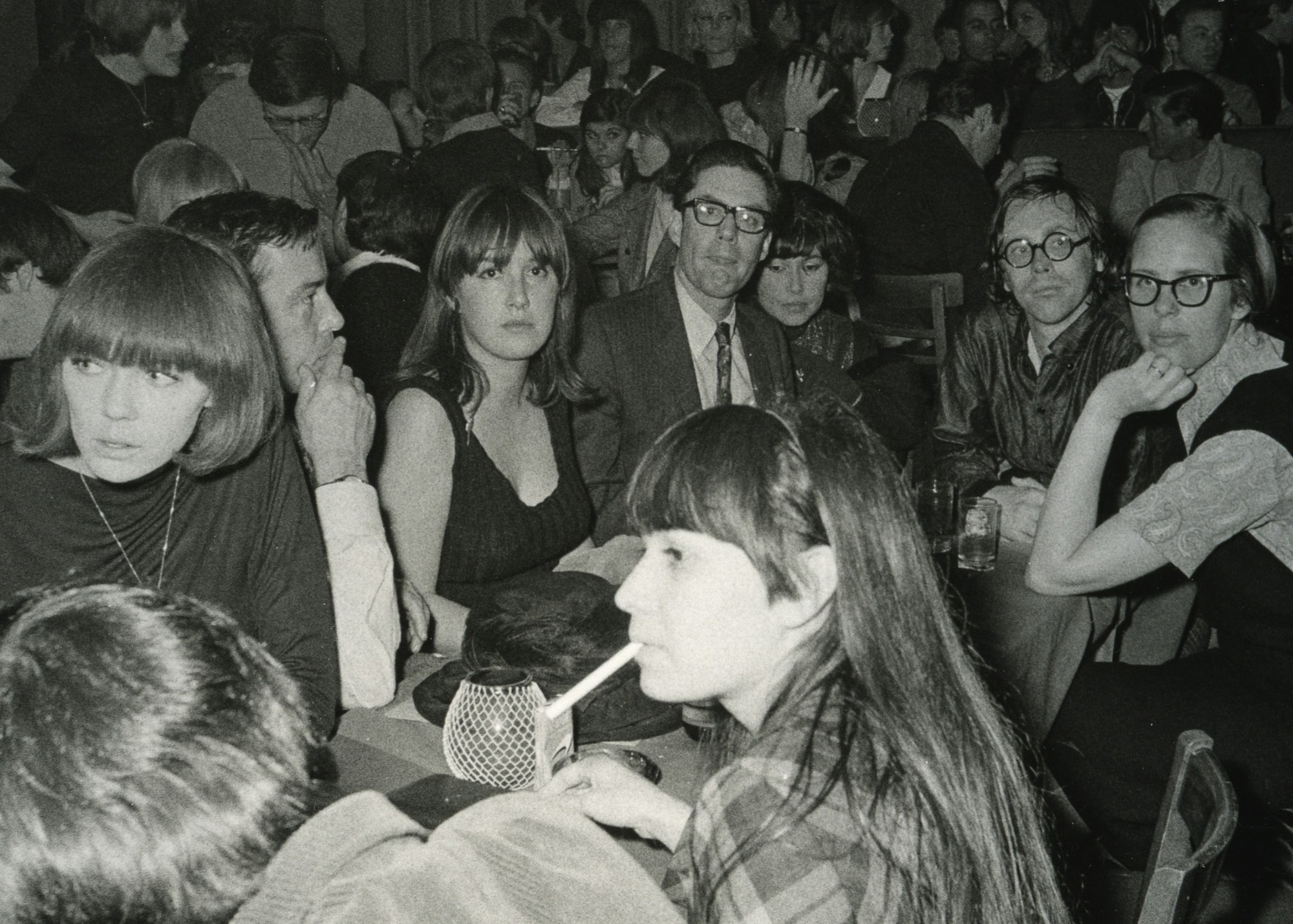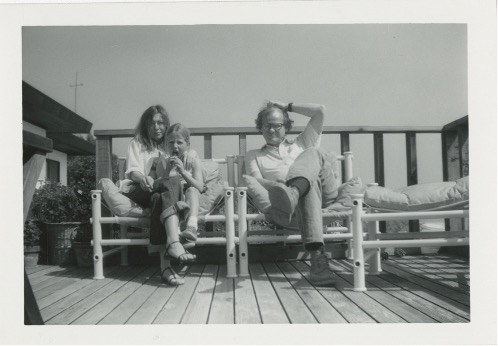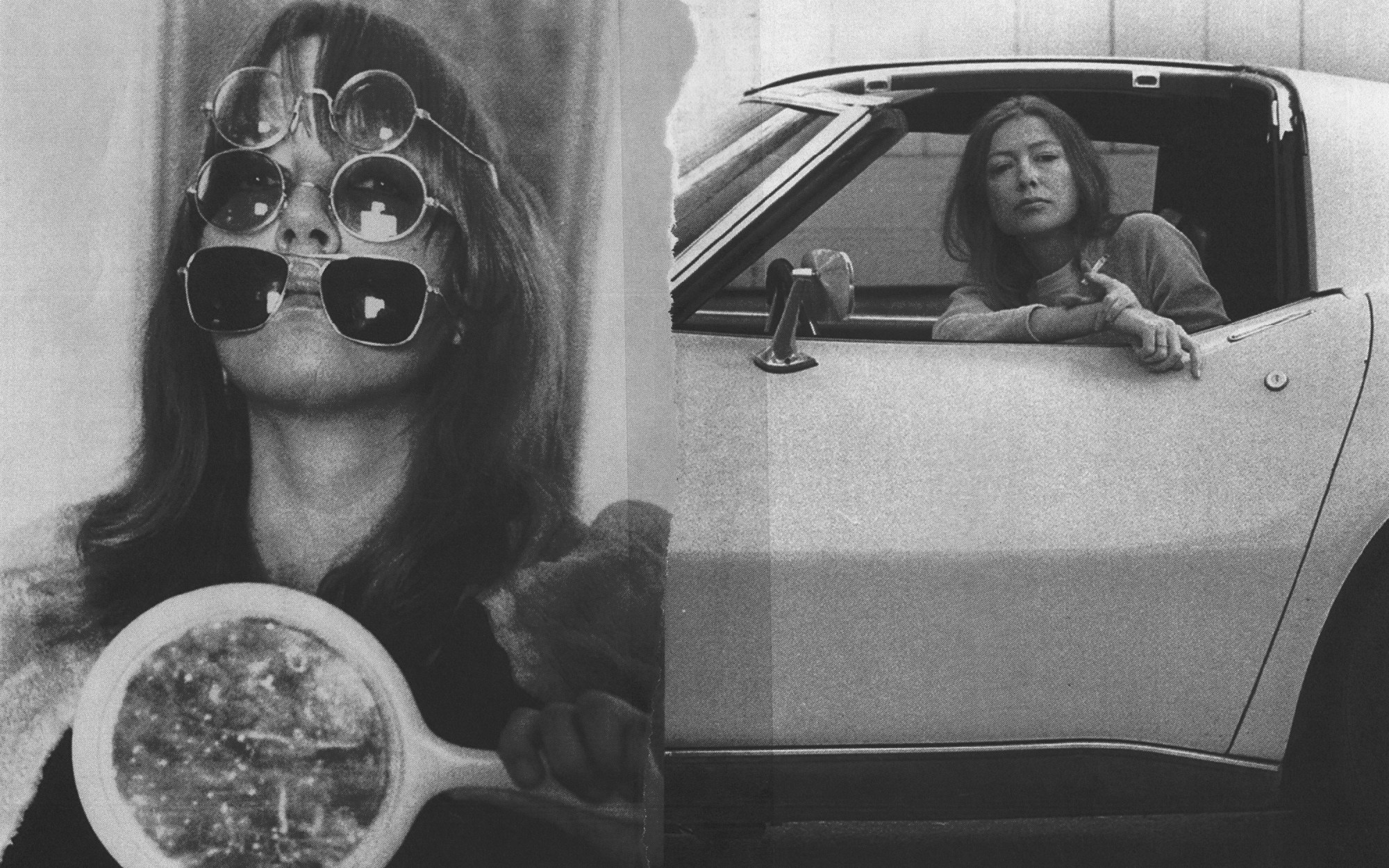Joan Didion is on C-SPAN in the year 2000. Eve Babitz of Hollywood is on the line. Thirty-six minutes into this three-hour sweep of Didion’s formidable career – in which the literary titan has already discussed the Manson murders and The Central Park Five and the centre not holding on Haight-Ashbury, the charade of America’s political processes and her opinions on rock stars – Babitz calls up just to say how nice it is to see her friend on the air. Back in the 60s, Babitz reminisces – the effervescence of her voice barely masking her shrewdness – Didion seemed like the “the only sensible person in the whole world.” She could make dinner for 40 people with one hand tied behind her back. She had “Spode china.”
Visibly amused, Didion laughs and says “Evie” used to attend parties at her old house on Franklin Avenue in Hollywood. That crumbling mansion was a focal point around which Didion immortalized late-60s and early-70s tales of apocalyptic rock’n’roll, upheaval, and death in the title essay of her totemic 1979 collection The White Album. Babitz – goddaughter of Stravinsky, self-identified groupie, album-cover collage artist, famed nude chess partner of Marcel Duchamp – presented a more awed and pleasure-oriented vision of Los Angeles in her debut book, 1974’s Eve’s Hollywood. At the turn of the millennium it was forgotten.
This minute-long clip of pre-9/11 book media circulated in 2021 when the authors died within a week of each other, a moment which felt like the universe had called back these two translators of the California subconscious in tandem. It plays their fine-tuned personas exactingly. There sat the ambitious and disciplined daughter of Sacramento behind her oversized shades, an icon and institution with a style so distilled it became an adjective: Didionesque. Disembodied was the eccentric and enthusiastic Babitz, pre-rediscovery of her It-Girl champagne chronicles, post-life-threatening-fire, at this point lost in time. One of them had two National Book Award nominations; the other, a never-produced screenplay entitled Portrait of the Artist as a Young Slut. For a new generation, this delightfully bewildering public interaction probed many questions about the possible depths of friendship between two autobiographical prose stylists who could not have been more temperamentally at odds.

Answers arrive in Didion & Babitz, a new compendium of gossip assembled by Vanity Fair writer Lili Anolik. With its hilarious promo copy – “Joan Didion, revealed at last” – it’s a self-consciously tabloid-y book that follows Anolik’s 2019 Babitz biography Hollywood’s Eve, recycling much material but building off the author’s new access to a trove of Babitz’s letters. The story Anolik tells herself, and wants to tell us, is that Didion and Babitz represent the two opposing but complementary sides of “American womanhood.” In 2024, this too-neat binary recalls none so much as Charli and Lorde clearing the Brat-summer air on “Girl, so confusing”: the intellectual and the sensualist, Apollonian and Dionysian, the poet and the party girl. Here are two pillars of California letters and female interiority who would never quite work it out on the remix, in edits, on the book jacket, or, alas, on “Book TV.”
From Anolik, we learn just how intimate Didion and Babitz’s friendship briefly was. It was Didion who initially contacted Rolling Stone editor (and future Babitz boyfriend) Grover Lewis in July 1971 and suggested he publish Babitz’s first story, “The Sheikh” – a Proustian reverie of beauty in the form of a Hollywood High diary – during a time when Babitz was dating Didion’s friend, the journalist Dan Wakefield. While this fact appears in Anolik’s 2019 book, here she has uncovered the letter itself. “The piece surprised me,” Didion wrote to Rolling Stone of “The Sheikh.” “I liked it very much & suggested she send it to you to see if you might be interested in publishing it.” The byline “practically saved my life,” Babitz said. “If Joan hadn’t sent [Lewis] a letter in the first place,” she wrote to Wakefield, “he never would have taken the story.” Other letters suggest Babitz secured her contract for Eve’s Hollywood by way of her proximity to Didion, too. The book’s publisher, Sam Lawrence, writes to Didion and her husband, the author John Gregory Dunne: “Help Eve and you’ll help us all.”
Most surprising is what that “help” entailed. Didion and Dunne were the original “editors” on Eve’s Hollywood – not an officially-sanctioned working relationship, but rather the first readers giving Babitz notes on the manuscript. Babitz brags about this in letters to friends, including one incredible note to Rolling Stone founder Jann Wenner where she goes, “I’ve got the crowned heads of literature… editing it for me, so if it’s not good it’ll be their fault.” Amazing.
Obviously, that doesn’t end well. Babitz had to, in her words, “fire” Didion and Dunne in order to preserve her loose, fever-pitched voice, to keep them from tempering her freewheeling spirit and her crucial pursuit of fun. But the depths of Babitz’s internal dilemma as she forged her own path were clear in a letter she wrote, a few years later, to Catch-22 author Joseph Heller – who blurbed her career-defining 1977 collection Slow Days, Fast Company. “I think sometimes that if I were really serious I’d ‘master my craft,’ but I have this overriding feeling that I’m inventing my craft as I go along,” Babitz writes, and insists she is “NOT going to copy out Ernest Hemingway novels by hand to ‘learn’ how to write novels,” alluding to Didion. “(Am I?)”
Babitz’s aversion to critique from Didion or anyone in the 70s begins to feel a tad self-sabotaging
Didion and Dunne had nonetheless already set off a chain of events that changed Babitz’s life and structured her work to come. After reading early pages, the couple suggested she break her draft up into two books, which became Eve’s Hollywood and her later novel Sex and Rage. The cheque for Eve’s Hollywood helped, too. “You have no idea what this advance for the book has done for me,” she wrote to a friend. “I’m freed for once in my life to not have to worry about money – it was all I ever needed, after all” — money and an L.A. bungalow of her own in order to create works of genius.
It is ironic that this plot point about editing would sit at the heart of Didion & Babitz, which reads so frustratingly like a first draft. About halfway through, I had to wonder if Anolik views her own messiness as some kind of tribute to Babitz, whose critics often called her writing “sloppy.” It doesn’t work. Anolik’s Babitz-aping tone, incessant flimsily-supported claims against Didion, and trivial interjections quickly become insufferable. On page 199, she finally admits to “distorting reality” in service of her narrative. “I’ve picked my side: Eve’s,” she writes. “Joan is somebody I naturally root against.” This could be entertaining, if she didn’t weigh the book down with embarrassing condescension to the reader, frequent parentheticals attempting to excuse her incoherent timelines, and blithe admissions to holes in her research.
Anolik states, for instance, that she was unaware of the existence of Didion’s post-college boyfriend Noel Parmental Jr. until 2022. But it’s well-known that Parmental was an early advocate of Didion’s writing, and he is quoted at length in the 2015 Didion biography The Last Love Song; his presence here is not the dramatic scoop Anolik lays claims to. As for Anolik’s barrage of weak theories, among the lowest she swings is asserting that the sudden death of Dunne in 2003 must have been tantamount to “the answer to a wish or a prayer” for Didion, who as a writer, Anolik posits, must surely have yearned to be alone. It seems that Anolik wants her book to be provocative, but what her dubious framework and baseless projections add up to is plain bad writing.

Didion and Babitz’s inverse political trajectories actually do fit the book’s premise of them as binary opposites. Didion was a young conservative who eventually registered as a Democrat (the first in her family ever to do so, she wrote in 2001’s Political Fictions, because she hated Reagan) but seemed more committed to exposing the whole system’s “fables” than anything else. Babitz, raised in a bonafide artistic salon by a violinist and a visual artist, became a right-wing MAGA extremist in the end. Anolik only touches on these threads. She mentions her subjects’ shared disdain for the women’s movement, but hardly approaches how each benefited from the evolving culture, how abortion was the prescient axis of Didion’s best novel Play It As It Lays, how the sexual freedom of the Sunset Strip groupie phenomenon that fueled Babitz’s persona would not have existed without the pill.
Overall, Didion & Babitz drastically oversells the purported “mutual antagonisms” of its subjects, which seem to be all Babitz’s. The tea is scorched: “Could you write what you write if you weren’t so tiny, Joan?” Babitz writes to Didion in an unsent letter, where she also derides her for dismissing Virginia Woolf. “Would you be allowed to if you weren’t so physically unthreatening?” But, eviscerating as she can be, Babitz’s own aversion to critique from Didion or anyone in the 70s begins to feel a tad self-sabotaging.
Didion gave Babitz an unmistakable desire to differentiate and magnify her true self
Two decades later, in Babitz’s 1993 collection Black Swans, which she wrote after getting sober, she meditated on the subject of jealousy: “It’s only temporary – you either die, or get better.”
Babitz’s comment that day on C-SPAN – “sensible” – is a not totally unsubtle slight, too, implying that Didion stood outside the palm-tree-lined bohemianism that Babitz made so seductive. “Sense” is what Babitz is rejecting when she “fires” Didion. In her own way, Didion sought control – but she resisted “sense” in her writing as well, by refusing easy narratives that soften the horrors of life.
When they met in 1967 – sharing a mutual friend in record exec and scene-maker Earl McGrath, who became the character Max in Babitz’s Sex and Rage, and to whom Didion dedicated The White Album – Babitz was 24 and Didion was 33. Babitz was counterculture; Didion was the culture. Babitz burned bright; Didion confronted the void. Babitz participated as sex-drugs-rock incarnate; Didion observed. Didion wrote in “On Self-Respect” that “innocence ends when one is stripped of the delusion that one likes oneself”; Babitz noted, in “Daughters of the Wasteland”, “It takes a certain kind of innocence to like L.A.” Didion exists in legible categories while Babitz remains beguiling, even as she classified her thinly-veiled personal stories as “memoir or essay or whatever you want to call it.” Part of the dizzying thrill of Babitz’s pen is: What exactly is this? You can just do this? Wow. (Not the deadpan of Didion’s unflinching “oh, wow” – just “wow.”)
Can’t friends value their differences? As with Anolik’s previous book, it’s the details that help redeem Didion & Babitz. I loved learning how Babitz first encountered Didion’s words in her Life column about vacationing in Hawaii “in lieu of filing for divorce,” and was so enthralled she pasted a tear-out into her 1969 scrapbook; how Didion and Dunne had a Babitz collage-portrait of drummer Ginger Baker hanging in their Malibu home; that Didion gave Babitz a book of John Berryman poems for Christmas in 1972. Babitz described Didion to a friend as “the one who told everyone what a good writer I was.” Perhaps Didion just wanted to do for Babitz what her ex-boyfriend Noel Parmental had done for her.
My own favorite Babitz sentence, from Slow Days, Fast Company, reads, “Once it is established that you are you and everyone else is merely perfect, ordinarily factory-like perfect… you can wreak all the havoc you want.” Catching me in a certain mood, Babitz’s musings on the beauty of imperfection, as relevant to strict aesthetic standards of the body as to art, in ’77 as now, can move me to tears. That one sentence captures her uninhibited essence with such nerve and eloquence and chaos and glamor that I had to quote it in a 2019 review of Lana Del Rey’s Norman Fucking Rockwell. What could be more Babitz-coded than the romantically smoggy sprawl of Lana’s “Venice Bitch” or her singing, on “Happiness Is a Butterfly”, “If he’s a serial killer, then what’s the worst that could happen to a girl who’s already hurt?” But then, who’s more proto-Lana than Tuesday Weld professing her love of the freeway in Play It As It Lays?
Babitz’s spell has proved irresistible for many since its re-emergence in the 2010s. For my part, I bought the NYRB reprint of Eve’s Hollywood on my first trip to Los Angeles in my late-20s, communing with its pages over date shakes in the sunshine and plastic cups of wine on the Starliner; right after, I read Slow Days, Fast Company, while traversing the deserts and highways of the Southwest on tour with a rock band. Not a year later I moved to Los Angeles on a whim for four months, restlessly, somewhat recklessly – Babitz-style – into the condo of a male musician who I was already pretty sure did not want to be with me. His offer to spend the winter there still stood, however. (He’d read Babitz, too, at my suggestion; his dog’s name was Joan, by the way.) This is writing that has the power to upend your reality, your sense, in lieu of adventure no matter the consequences. It stokes possibilities like punk in the 70s. You read Babitz and think, there is a world out there waiting for me to stake my claim, to create it. And, given the option, why not go, even if it hurts?
“I am more of an artist than a writer,” Babitz asserts in her Eve’s Hollywood introduction. She’s both; and at these crosshairs, I’d argue, Didion and Babitz align. Didion eternally typifies the journalist-as-artist for whom “grammar is a piano I play by ear.” But Babitz seemed eager to distinguish herself from an establishment she rejected. Didion and Dunne are coolly thanked in the Eve’s Hollywood acknowledgments for “having to be who I’m not.” Knowing what you aren’t, what you don’t want, is a fundamental part of growth. More than recommendations or edits, what Didion gave Babitz was an unmistakable desire to differentiate and magnify her true self, to establish what her voice was. It’s the ultimate gift.
